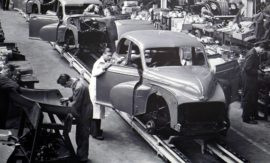Intended learning outcomes: Identify influencing factors of cooperation between R&D and Engineering. Disclose two fundamental cooperation types in ETO companies.
In terms of cooperation between R&D and Engineering, the following influencing factors were noted from the observations in companies and from the literature. Thereby, the influence of the factors are not of equal weight in each company.
- Sales volume, or the number of orders (for lot size one (batch size one), this is equivalent to the number of units). According to [WiPo16], two or more orders per day counts as a high sales volume, and a dozen orders per year as a low sales volume.
- Level of integration of product design and guidelines: A high level means that knowledge about the method of generation of customer-specific components using OSE has been integrated into the PD process, and therefore into the product design guidelines and the product configurator.
- Degree of product customization: From the company's perspective, a high degree means that it involves developing new components, rather than just adapting existing ones.
- Level of component engineering complexity: A high level means that the OSE contains a high measure of time and effort to adapting components, or developing new ones.
- Level of architecture engineering complexity: A high level means that the combination and interfaces of (main) components in the product have to be newly developed and produced each time, as is often the case in e.g. plant engineering.
- Accuracy of estimating the duration of OSE. A high accuracy also involves a high level of component modularization and commonality, making it easy to estimate time and effort needed to select them and position them in the product (whether time and effort needed are low or high).
Being more precise about “high” or “low” for all six influencing factors (e.g. using mathematical formulae) depends on the product and on the competitive situation, and is usually difficult to implement in practice. However, even using just two simple values, i.e. “high” and “low”, the examples of GE and Schindler show clear differences in two fundamental types of cooperation between R&D and Engineering, as shown in Figure 7.5.2.1.
GE Industrial Steam Turbines belongs to the high cooperation type, whilst Schindler high rise elevators is of the low type. [SöWe17] present further companies that fit this division.
Figure 7.5.2.1 Two fundamental cooperation types in ETO companies
[SöWe17] also contains examples of ETO companies with two other types of cooperation, which fall between the two types in Figure 7.5.2.1. This situation entails a two-dimensional classification.Continuation in next subsection (7.5.2b).
Course section 7.5: Subsections and their intended learning outcomes

7.5 Cooperation between R&D and Engineering in ETO Companies
Intended learning outcomes: Describe different means used for cooperation between the R&D and the order-specific engineering departments. Present the portfolio of cooperation types between R&D and engineering in ETO companies.

7.5.1 Different Means Used for Cooperation between the R&D and the Order-specific Engineering Departments
Intended learning outcomes: Present in detail design and specification of a product in an ETO environment as five phases of potential cooperation between R&D and Engineering along the value chain. Explain the ETO businesses of industrial steam turbines and high-rise elevators.

7.5.2 Two Fundamental Cooperation Types in ETO Companies
Intended learning outcomes: Identify influencing factors of cooperation between R&D and Engineering. Disclose two fundamental cooperation types in ETO companies.

7.5.2b The Portfolio of Cooperation Types between R&D and Engineering in ETO Companies
Intended learning outcomes: Explain the portfolio of cooperation types between R&D and Engineering in ETO companies.
